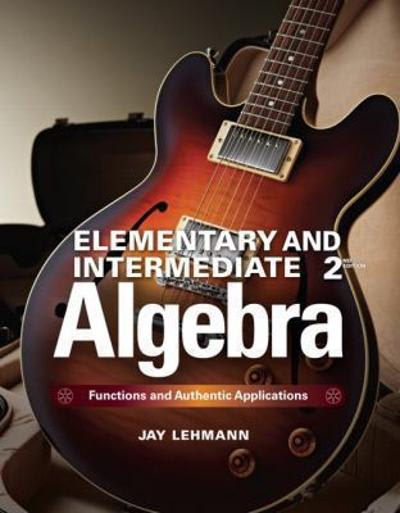Question
Design your own game similar to the example in the course notes on page 89 and the lotto example in the document in CANVAS/FILES called
Design your own game similar to the example in the course notes on page 89 and the lotto example in the document in CANVAS/FILES called RANDOM VARIABLES. Do not use a die roll for your game. Some ideas could use cards, spinners, or a similar device.
Your game should have a negative expected value (favors the house not the player) and at least one positive payout. So you have to think about this a bit to make sure it works out correctly.
- Describe the scenario, and provide the probability distribution table for the payout scheme. (10 pts)
- Based on your probability distribution, compute the mean payout per play and the standard deviation using the formulas for each and the table from #1. (10 pts)
- Simulate 10000 plays of your game in Statcrunch (10 pts):
Create a column called "game", and enter values that simulate the correct the probability of each outcome. For example, for the example in the course notes p. 89, I would enter
game
1
1
- 1.50
- 1.50
-1.75
2.5
Then click Data / Sample. Choose "game" as variable. Change the sample size to 10000 and check SAMPLE WITH REPLACEMENT. Click Compute.
Use Statcrunch to compute the mean and standard deviation of your 10000 simulated plays. Copy and paste the summary stats showing n, mean and standard deviation.
If your values are not close to your answers for question #2 , then you made a mistake!
Part 2
Create a Binomial Probability Experiment. Recall that this means the experiment must have n independent success/failure trials with the probability of success (p) and failure (q) the same each time. Choose value for n that is between 50 and 100 for your scenario.
- Describe your scenario here. Define a Binomial Random Variable X. (20 pts)
Make sure you clearly define what a success is, and what n, p, and q are for your scenario. There is no specific value of x here, since this is a general scenario not associated with a particular number of successes. So don't give me an example problem from the internet that is computing the probability of a specific number of successes.
OFF LIMITS: coin flips, die rolls, any example I have used in class.
- Illustrate your scenario, either by a photo, original art, clip art, or any other illustration. (5 pts)
- YOU WILL ONLY WORK ONE OF THE FOLLOWING OPTIONS BASED ON YOUR SCENARIO. (10 pts)
- If your value of p is less than or equal to .5, Use Statcrunch/ Stat/ Calculators/ Binomial to find the probability that 2/5 OR MORE of your trials result in a success.
- If your value of p is greater than .5, Use Statcrunch / Stat/ Calculators/ Binomial to find the probability that at 3/5 OR LESS of your trials result in a success
For example, if n= 50 and p = .6, you would find P(X <= 50*3/5) = P(X <= 30).
For example, if n= 50 and p = .4 you would find P(X >= 50*2/5) = P(X >= 20).
Round up to next whole number if n *2/5 or n * 3/5 is not a whole number.
- Compute the mean and standard deviation for your scenario by hand using formulas mean = np and std dev. = sqrt(npq). (10 pts)
- Use Statcrunch to simulate 10000 rounds your experiment (10 pts):
Select Data/ Simulate / Binomial. Enter 10000 for rows, and 1 for columns. Enter the values for n and p for your scenario. Click Compute. Create a relative frequencyhistogram of your results. Show it here:
Approximate the answer to part c by placing the cursor over the graph for the appropriate classes and added up the relative frequencies. If your answer is not very close to your answer for part 2 question 3a, then you made a mistake.
( 15 pts) 6. Symmetric distributions are often well -approximated with a normal distribution. One example of this is the Binomial Distribution , which can be approximated by a normal distribution if the value of n*p and n * (1-p) are larger that 10 .
Look at the example course notes on pages 269 and 270 . Then answer the question here :
An experiment consists of drawing 50 cards from a standard deck .
Let the Random Variable X = the number of Spades drawn out of the 50 selections.
( 3) a. For this binomial experiment , what are the values of n , p, and q ?
( 4) b. What are the mean and standard deviation for X?
( 3) c. What is the actual probability of selecting at least 12 spades ? ( Use statcrunch binomial distribution calculator) .
( 5) d. Use the normal approximation to the binomial ( with continuity correction) , to approximate the probability of selecting at least 12 spades . Use the Statcrunch normal distribution calculator .
Step by Step Solution
There are 3 Steps involved in it
Step: 1

Get Instant Access to Expert-Tailored Solutions
See step-by-step solutions with expert insights and AI powered tools for academic success
Step: 2

Step: 3

Ace Your Homework with AI
Get the answers you need in no time with our AI-driven, step-by-step assistance
Get Started


